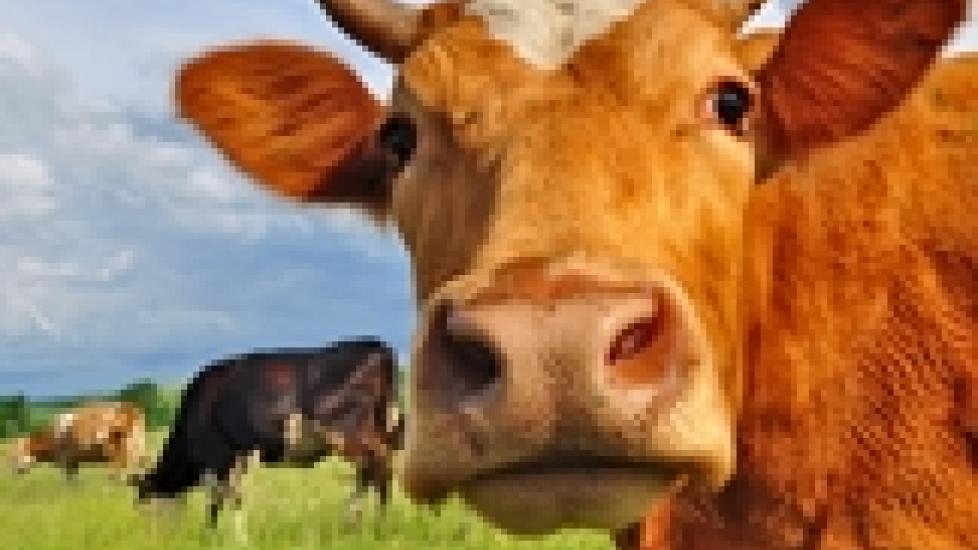When Livestock Stress Out: Gastric Ulcers, Part 2
Last week we talked about gastric ulcers in horses. Similar to humans, horses can develop these ulcers for many reasons, including physical and environmental stress, but what about cows?
As you might recall from previous posts, cows have a unique digestive system comprised of four different stomachs. The last of the four stomachs, right before food enters the small intestine, is called the abomasum. This is considered the “true” stomach because unlike the previous three organs, the abomasum secretes acidic gastric juices to aid in digestion. (The previous three organs rely mostly on microbes for fermentation of the ingested plant material.)
OK, so we’ve figured out the potential location for gastric ulcers should they occur in cows, but why? How on earth could a peaceful-seeming, grass-munching, tail-swishing, cud-chewing, tail-flicking ruminant get ulcers?
Again, the answer lies in stress. For dairy cattle, the most common time for abomasal ulcer development is within the first six weeks of calving. This is an extremely physiologically challenging time for a cow: her milk production has gone from zero, prior to calving, to upwards of eight gallons a day; her internal organs have been rearranged after delivering a one hundred pound calf; her diet has changed to support her milk production; her uterus is shrinking down to a normal size, repairing itself after birth; and her ovaries are preparing to ovulate once again. Talk about mood swings! (Just kidding.)
But seriously, all this stuff quite easily throws things out of whack. Metabolism changes and predisposition to infection in the udder and the uterus taxes the cow’s system to the max and sometimes ulcers are a result.
For beef cattle, the transition from pasture to the feedlot often coincides with ulcer formation. During this switch, the animal’s diet undergoes a massive change, from eating pasture and possibly some grain to eating a high concentrate feed designed to obtain maximal weight gain and muscle growth prior to slaughter. As with equine ulcers, lack of roughage can increase gastric emptying and predispose a steer or heifer to ulcers.
So how does one know if a cow has an ulcer? With horses, we learned last week that a definitive diagnosis is made with an endoscope to visualize the ulcer. This cannot be done in bovines. The presence of the massive 50-gallon fermentation vat that is the rumen, which is located in front of the abomasums, prevents any endoscope from making the journey from the esophagus to the “true” stomach. Not only would a scope get lost on the voyage, but the rumen is so filled with feedstuffs that you’d never make it through the choppy seas of grass, hay, and grain no matter how industrious a vessel your endoscope was.
Instead, most abomasal ulcers in bovines go undiagnosed, or are diagnosed based only on presumption. To put it bluntly, it often doesn’t matter if the ulcer is diagnosed or not, since there is no suitable treatment for abomasal ulcers in ruminants like there is for horses. The reason is the design of the ruminant digestive system. For an oral drug to make it to the abomasum, it must first survive the other three stomachs. Omeprazole, the ulcer treatment of choice for horses, does not respond well to the three stomach voyage to the abomasums in a cow.
Instead, environmental changes, dietary changes, supportive care, and treatment of other possible simultaneous health problems are needed. I say simultaneous health problems because most cattle with ulcers, especially dairy cattle, have other issues going on, such as mastitis (inflammation of the udder), metritis (inflammation of the uterus), ketosis (a metabolic problem when the body is producing ketones for energy), and/or other gastrointestinal problems. If you work on those problems, provide adequate nutrition, and some TLC, she will hopefully recover from her ulcer issues as well.
One gruesome but oddly positive twist on this condition is that occasionally, cows have perforating ulcers. Yes, this can be lethal if the perforation is near a large blood vessel. But sometimes the perforation happens and the cow’s amazing immune system builds large amounts of fibrin around the internal wound, walling it off from the rest of the body. Essentially, the cow creates her own internal band-aid that patches the hole in her abomasum. And then she lives to tell the tale. Or not tell the tale, in most cases. Usually this happens and the farmer (and vet!) are none the wiser.

Dr. Anna O’Brien
Image: smereka / Shutterstock
More to Explore:
Recommended Pet Products
- Nutramax Proviable Probiotics & Prebiotics Digestive Health Supplement for Dogs & Cats, 160 count$89.98Chewy Price
- Fera Pets USDA Organic Pumpkin Plus Fiber Support for Dogs & Cats, 90 servings$34.95Chewy Price
- All Four Paws Comfy Cone E-Collar for Dogs & Cats, Black, Small$20.24Chewy Price
- Virbac Epi-Otic Advanced Ear Cleaner for Dogs & Cats, 4-fl oz bottle$12.34Chewy Price




